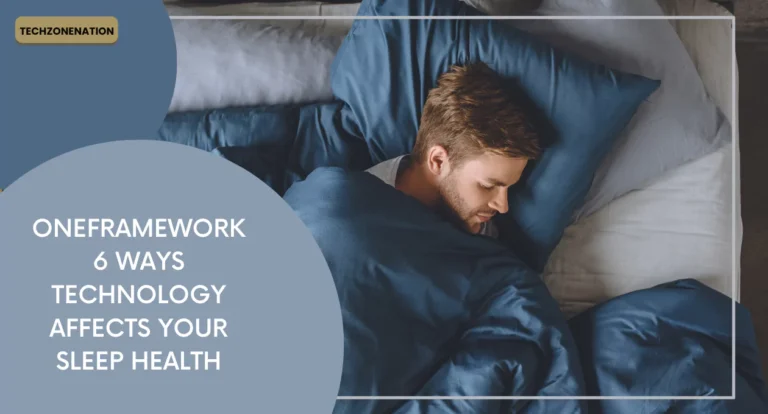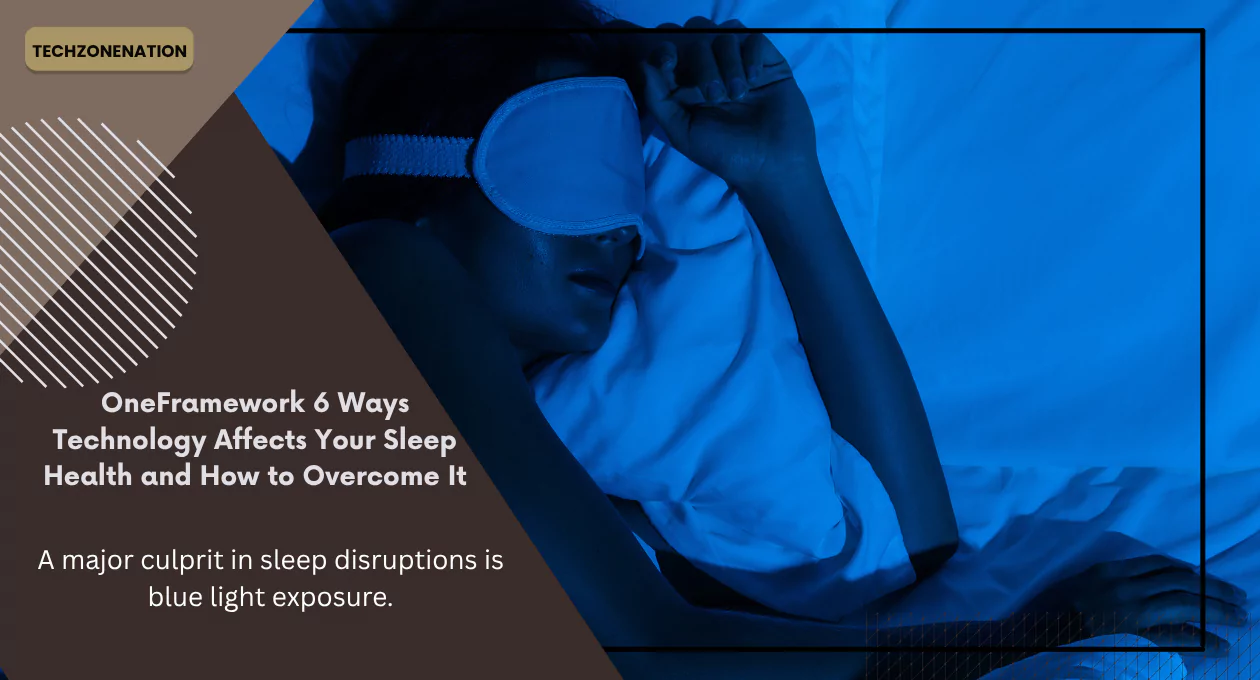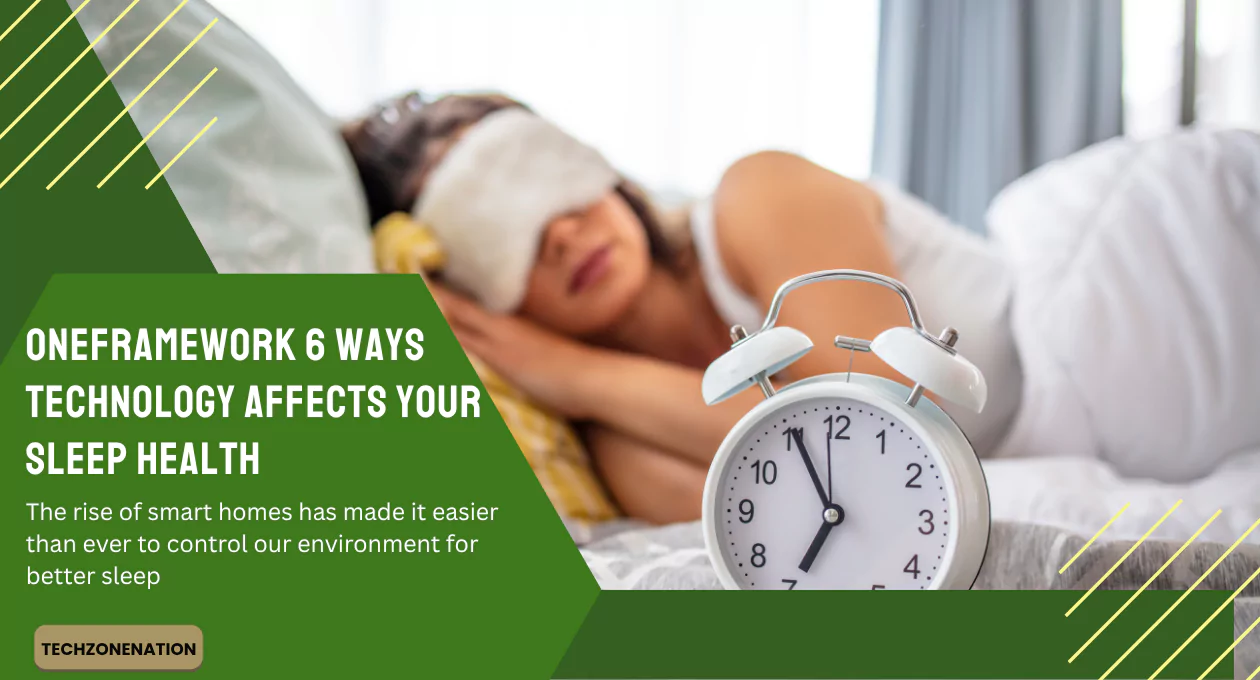
In today’s fast-paced world, technology is an integral part of our daily lives, from smartphones to smart homes. However, OneFramework 6 Ways Technology Affects Your Sleep Health explores the darker side of this digital revolution. While tech innovations have certainly improved various aspects of life, they also contribute to significant sleep disruptions. The constant exposure to blue light from screens, the rise of mental overstimulation before bed, and even the constant flow of notifications can negatively impact sleep quality.
These disruptions lead to issues like circadian rhythm disruption and sleep anxiety, making it harder for individuals to maintain healthy sleep patterns. In this article, we’ll dive deep into how technology impacts sleep and offer practical solutions to regain control over your sleep hygiene in the digital age. Understanding these effects is crucial for improving your overall well-being and ensuring restful, uninterrupted nights.
Introduction to Sleep and Technology
Sleep is one of the most important factors in maintaining our health. It’s when our bodies repair themselves, our minds recharge, and we prepare for the next day. Yet, sleep disruptions have become a common issue, particularly with the rise of technology. As smart homes, wearable devices, and constant connectivity have become part of everyday life, more people are reporting poor sleep quality.
The introduction of smart devices and tech-based sleep aids has brought both advantages and disadvantages. While they can be useful in improving sleep patterns and promoting sleep hygiene, they also contribute to sleep disorders and affect our natural sleep cycles in negative ways. Understanding how technology for better rest works and how to manage its impact is crucial for improving your sleep health.
The Link Between Technology and Sleep Disruption
Technology and sleep are not always a good combination. More and more studies reveal that mental overstimulation from smartphones, laptops, and tablets before bed disrupts the body’s ability to wind down. When we look at screens, we expose ourselves to blue light, which interferes with our natural circadian rhythm.
The result? Sleep fragmentation and frequent micro-awakenings. This can leave us feeling tired and unrested even after hours in bed. It’s not just about the blue light exposure, but also how tech keeps our minds alert, preventing us from entering deeper stages of REM cycles and deep sleep. Understanding this link can help us identify the tech habits that need to change in order to improve our sleep quality management.
Blue Light Exposure and Circadian Rhythm Disruption
A major culprit in sleep disruptions is blue light exposure. Blue light, emitted by phones, tablets, and computers, tricks our brain into thinking it’s still daylight. This disrupts the production of melatonin, a hormone that signals the body to prepare for sleep. As a result, circadian rhythm disruption occurs, making it harder to fall asleep at night.

When you use tech devices late in the evening, your brain may stay alert, which makes it difficult to enter deep sleep or achieve quality REM cycles. The longer you stay exposed to blue light, the greater the impact on your ability to wind down before bed. To mitigate this, consider using blue light filters or limiting screen time an hour before you go to sleep. It’s all about managing nighttime digital habits to ensure your sleep health isn’t compromised.
Mental Overstimulation Before Bed
One of the key issues with technology and sleep is mental overstimulation. Many people use their phones or laptops right before bed, scrolling through social media, checking emails, or watching videos. While these activities may seem relaxing, they actually keep your brain active when it should be winding down.
Mental overstimulation prevents the brain from slowing down and transitioning into sleep mode. Engaging with emotionally charged content or even doomscrolling—the act of endlessly scrolling through negative news—can cause sleep anxiety and make falling asleep much harder. To counteract this, develop a calming wind-down routine. Consider reading a book, practicing mindfulness, or meditating instead of turning to screens.
Notifications and Nighttime Interruptions
Notifications from social media, emails, or messaging apps can cause unnecessary nighttime interruptions. Every ping or buzz can disturb your sleep, especially during the night when you should be getting restorative rest. Even if you don’t fully wake up, these disruptions lead to micro-awakenings, preventing you from getting deep and restorative sleep.
The constant interruption from these notifications creates sleep fragmentation, leaving you groggy in the morning. It’s essential to set tech boundaries before bed. Turning off notifications, activating “Do Not Disturb” mode, or keeping devices out of the bedroom can help promote a peaceful and uninterrupted sleep environment.
Sleep Tracking Devices: A Double-Edged Sword
Sleep tracking devices have become increasingly popular as people look for ways to improve their sleep health. These devices monitor everything from sleep patterns to REM cycles. While they can offer valuable insights into your sleep health, they may also contribute to sleep anxiety. Constantly checking these devices can cause you to fixate on sleep quality, which can ironically make it harder to relax and fall asleep.
In some cases, the obsession with tracking every aspect of your sleep can lead to a condition known as orthosomnia—a psychological condition where individuals become overly focused on perfect sleep. To avoid this, use tracking devices sparingly and focus on the bigger picture of improving your overall sleep hygiene and mental health and sleep.
Environmental Control: Smart Homes and Sleep Hygiene
The rise of smart homes has made it easier than ever to control our environment for better sleep. Devices like smart thermostats, adjustable lighting, and noise machines can create an ideal sleep environment control. However, it’s important to remember that a tech-driven sleep environment is only effective if it is used mindfully.

Improving sleep hygiene involves more than just adjusting the temperature or lighting. It also means maintaining a clean, quiet, and dark environment that fosters a natural sleep cycle. Smart technology can be a powerful tool in this, but relying on it too heavily or without proper regulation can add more distractions than benefits. A balanced approach to environmental control is essential for maintaining long-term sleep health.
Social Media and Emotional Stimulation
Social media impact on sleep is undeniable. Many people check social media right before bed, exposing themselves to emotionally stimulating content. This could be anything from exciting updates to distressing news. These emotional triggers can make it difficult to unwind, leading to mental overstimulation and disrupted sleep patterns.
When you engage in stimulating activities on your phone, especially on platforms that trigger emotional stimulation, you set yourself up for a restless night. Sleep disorders like insomnia or anxiety can stem from too much emotional activity before bedtime. To combat this, limit social media usage in the hour leading up to sleep. Creating tech-free habits before bed can help you improve your sleep hygiene.
Strategies to Mitigate Technology’s Impact on Sleep
It’s clear that technology and sleep don’t always go hand-in-hand. However, there are several ways to mitigate its impact on your sleep health. Start by establishing tech boundaries before bed. Set aside at least one hour before sleep without screens. Use this time to relax and focus on activities that help you wind down, such as reading a book, practicing yoga, or journaling.
Another key strategy is to reduce blue light exposure at night. You can do this by using blue light filters or switching to apps that adjust the screen tone as the day turns to night. Additionally, practicing mindfulness and relaxation techniques can help ease mental overstimulation and improve sleep quality.
Reclaiming Sleep in the Digital Age
In the age of constant connectivity, reclaiming quality sleep can feel like an impossible task. However, it is possible to take control of your sleep health in this digital era. Establishing healthy sleep routines, limiting screen time before bed, and using technology for better rest are all steps that can help you sleep better.
OneFramework can be an invaluable resource in this journey. With its tools and strategies, you can create a more mindful relationship with technology and improve your sleep quality management. By integrating tech-free habits and regulating device usage, you can overcome the disruptions caused by technology and reclaim restful, rejuvenating sleep.
FAQs about oneframework 6 ways technology affects your sleep health
How does technology affect my sleep health?
Technology impacts sleep health by disrupting circadian rhythm through blue light exposure, causing sleep fragmentation and mental overstimulation. Devices like phones and laptops make it harder to fall asleep and stay asleep, affecting sleep quality and overall well-being.
What is blue light and how does it impact sleep?
Blue light, emitted by screens, interferes with melatonin production, making it difficult for your body to prepare for sleep. This disrupts your circadian rhythm, leading to poor sleep health and reduced deep sleep.
Can social media affect my sleep?
Yes, social media can lead to emotional stimulation before bed, causing mental overstimulation. Engaging with emotionally charged content can make it harder to wind down, leading to sleep anxiety and poor sleep patterns.
How can I reduce the impact of technology on my sleep?
To reduce the impact of technology on sleep, establish tech boundaries by turning off devices an hour before bed. Use blue light filters and focus on calming activities like reading or meditation to improve sleep hygiene.
Are sleep tracking devices helpful or harmful?
Sleep tracking devices can provide useful insights into your sleep patterns, but over-reliance can lead to sleep anxiety and obsession with perfect sleep. Use them as a tool, but avoid letting them dictate your rest or cause unnecessary stress.
Conclusion
In conclusion, technology has revolutionized many aspects of our lives, but it has also posed significant challenges to our sleep. By understanding the effects of blue light exposure, mental overstimulation, and sleep tracking devices, we can take steps to improve our sleep health. With a mindful approach to technology use and practical strategies to manage its impact, we can all reclaim better sleep in the digital age.